Categories: Featured Articles » Electrician at home
Number of views: 33598
Comments on the article: 1
Maintenance and repair of electrical wiring
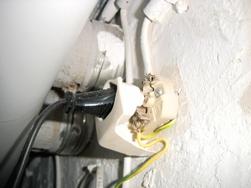 Overloads in electric Networks lead to heating of wires and cables above the temperature that is permissible for them in terms of safety and reliability.
Overloads in electric Networks lead to heating of wires and cables above the temperature that is permissible for them in terms of safety and reliability.
For wires and cables with rubber and plastic insulation, PUEs set the maximum permissible heating temperature + 65 ° C for a long current load. Permissible current loads depend on the cross section of the conductor, its design, cooling conditions and the laying method.
When overloaded in electric of the network aging of the insulation of conductors occurs: the rubber dries, crackes and crumbles, the plastic insulation and shell melt and soften, the paper braid is charred, etc. The weakening of the insulation over time leads to short circuits between the conductive conductors.
Short circuits can also be caused by malfunctioning of switches, sockets, unreliable connection in branch boxes, mechanical damage to the wire as a result of careless handling, malfunctioning of household appliances without protection, etc.
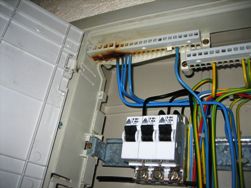 To protect the electrical wiring in case of abnormal clamps, there are protection devices that automatically turn off the electrical circuit when damaged, plug fuses, automatic threaded fuses (PAR) and circuit breakers (automatic machines).
To protect the electrical wiring in case of abnormal clamps, there are protection devices that automatically turn off the electrical circuit when damaged, plug fuses, automatic threaded fuses (PAR) and circuit breakers (automatic machines).
All elements of the electrical wiring — installation products, wires, cables, protection devices, etc. — are designed for a long service life, but over time they wear out, age, and fail. Therefore, the wiring and its elements should be periodically inspected and checked: at least 1 time in 2 years - in rooms with a normal environment and 1 time per year in the rest. Detected malfunctions should be rectified immediately.
Faults and damage to the wiring and its elements can occur due to careless handling, poor-quality installation work, and physical wear of wires and cables as a result of a long service life.
Switches, in which spring-loaded contact plates or cermet nanike have broken off, cracks appeared in the covers, cannot be repaired, they should be replaced immediately.
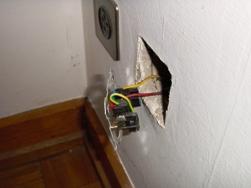 In sockets, springs compressing the contact slots become weaker over time, as a result of which the plug connection is heated, and the contacts are covered with carbon and are melted. To ensure reliable operation of the plug connection, it is necessary to replace the springs and provide a contact at which the pins of the plugs are held tightly in the sockets of the outlet. If there are no spare compression springs, the sockets should be replaced. This must be done in the presence of cracks and chips in the base and cover.
In sockets, springs compressing the contact slots become weaker over time, as a result of which the plug connection is heated, and the contacts are covered with carbon and are melted. To ensure reliable operation of the plug connection, it is necessary to replace the springs and provide a contact at which the pins of the plugs are held tightly in the sockets of the outlet. If there are no spare compression springs, the sockets should be replaced. This must be done in the presence of cracks and chips in the base and cover.
Sometimes when pulling the plug out of a hidden socket, the entire socket falls out along with the wires. Leave it in this form is impossible. You can also not try to insert the outlet into the box without turning off the power - this can lead to personal injury. When attaching the socket in the box, make sure that the wires do not fall under the spacer tabs. The foot fixing screws must be screwed in alternately and evenly. Moreover, when removing the plug from the socket, it is necessary to hold the socket cover with the other hand. This will prevent the socket from loosening in the box or on the support base.
When examining apartment shields, it is necessary to monitor the condition of the contacts at the places where the wires are connected. An unreliable connection leads to heating and burning of contacts, destruction of insulation and subsequent sparking. Such contacts must be promptly cleaned of soot, metal influx and tighten tight.
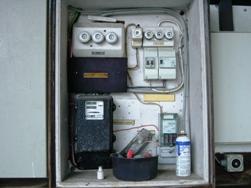 Circuit breakers and fuse-links should be suitable for the loads and cross-sections of wires and cables. The contact surfaces of the fuses must not contain traces of oxide, dirt, dust.
Circuit breakers and fuse-links should be suitable for the loads and cross-sections of wires and cables. The contact surfaces of the fuses must not contain traces of oxide, dirt, dust.
Protection devices with damaged housings or in case of refusal to work cannot be repaired, they must be replaced.
In apartment shields that have cabinets, there must be serviceable locks, reliable door sealing. Do not store foreign objects in these cabinets.
Electric meters should not have damage to the housing, sight glasses, terminal covers, etc.
Cabinets, protective devices and all accessible places should be regularly cleaned of dust and dirt. When inspecting internal wiring, the tension and fastening of wires and cables are checked. Saggy and loose wires and cables must be tightened and securely fastened.
Damaged casters, insulators, insulating tubes, porcelain funnels and bushings are immediately replaced. In this case, the work is carried out in accordance with the norms and rules for this type of wiring and method of laying. As a rule, damaged wiring is replaced in the area from the nearest branch in the box or insulating support to the place of damage.
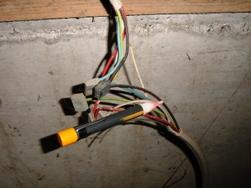 The newly laid wire is connected at the same points in the wiring where the connections were before repair.
The newly laid wire is connected at the same points in the wiring where the connections were before repair.
When monitoring external wiring and branch leads from the overhead line, the presence of burns, chips and cracks in the insulators is checked; breaks and fusion of wires, integrity of bindings, condition of connections; wire tension and compliance with the PUE of the distances between them, wires and ground, wires and building structures; condition of supports; Are tree branches close to wires dangerous?
At least 1 time in 3 years, the insulation of the network is checked with a megohmmeter with a voltage of 500 or 1000 V.
Insulation resistance measured between each wire and ground, and between every two wires when the network is disconnected. Lamps when measuring insulation resistance must be unscrewed, and the switches are on.
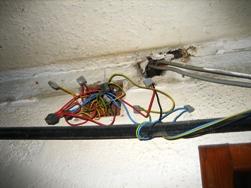 The smallest insulation resistance is 0.5 mOhm. When checking the insulation resistance, pay attention to the integrity and serviceability of grounding wires. If the insulation resistance of the wires is less than 0.5 mOhm, it is necessary to determine the cause and repair the damaged section or wiring element.
The smallest insulation resistance is 0.5 mOhm. When checking the insulation resistance, pay attention to the integrity and serviceability of grounding wires. If the insulation resistance of the wires is less than 0.5 mOhm, it is necessary to determine the cause and repair the damaged section or wiring element.
When checking determine the need for capital electrical wiring repair, general technical condition of wires and cables, fasteners, etc.
The main indicators in this case are:
1) insulation resistance of wires and cables is less than 0.5 mOhm and current leakage is more than 20 mA;
2) low mechanical strength of insulation of conductive wires (drying, cracking, shedding, brittleness);
3) overheating of the wire, cable and connections at network loads close to nominal.
Work associated with the inspection of electrical wiring and electrical installations and their repair must be carried out in strict compliance with safety regulations.
See also at bgv.electricianexp.com
:
